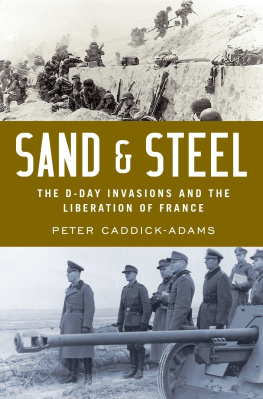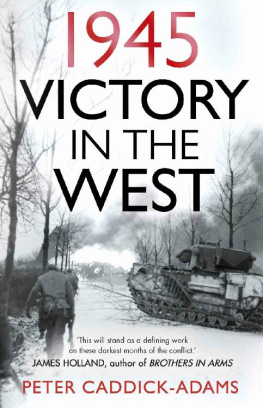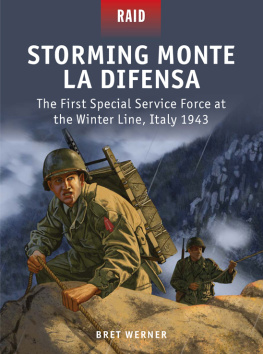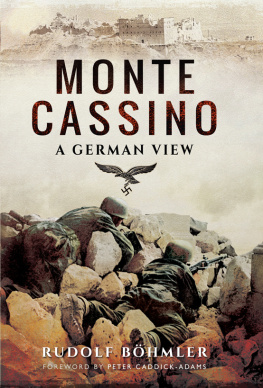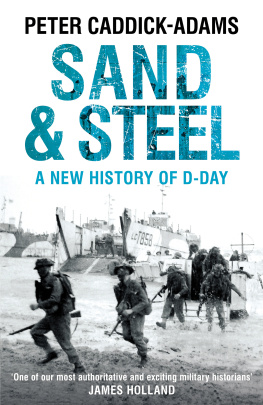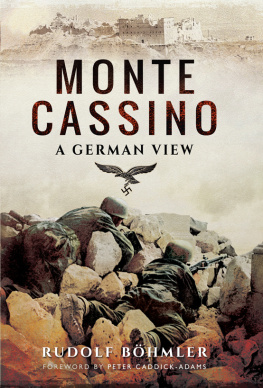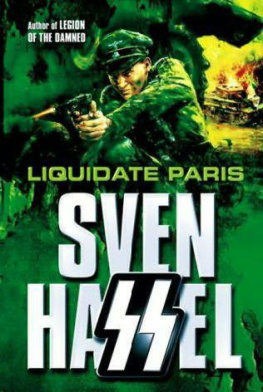Caddick-Adams - Monte Cassino: Ten Armies in Hell
Here you can read online Caddick-Adams - Monte Cassino: Ten Armies in Hell full text of the book (entire story) in english for free. Download pdf and epub, get meaning, cover and reviews about this ebook. City: USA;New York;Oxford, year: 2013, publisher: Oxford University Press, genre: Non-fiction. Description of the work, (preface) as well as reviews are available. Best literature library LitArk.com created for fans of good reading and offers a wide selection of genres:
Romance novel
Science fiction
Adventure
Detective
Science
History
Home and family
Prose
Art
Politics
Computer
Non-fiction
Religion
Business
Children
Humor
Choose a favorite category and find really read worthwhile books. Enjoy immersion in the world of imagination, feel the emotions of the characters or learn something new for yourself, make an fascinating discovery.

- Book:Monte Cassino: Ten Armies in Hell
- Author:
- Publisher:Oxford University Press
- Genre:
- Year:2013
- City:USA;New York;Oxford
- Rating:4 / 5
- Favourites:Add to favourites
- Your mark:
- 80
- 1
- 2
- 3
- 4
- 5
Monte Cassino: Ten Armies in Hell: summary, description and annotation
We offer to read an annotation, description, summary or preface (depends on what the author of the book "Monte Cassino: Ten Armies in Hell" wrote himself). If you haven't found the necessary information about the book — write in the comments, we will try to find it.
Monte Cassino: Ten Armies in Hell — read online for free the complete book (whole text) full work
Below is the text of the book, divided by pages. System saving the place of the last page read, allows you to conveniently read the book "Monte Cassino: Ten Armies in Hell" online for free, without having to search again every time where you left off. Put a bookmark, and you can go to the page where you finished reading at any time.
Font size:
Interval:
Bookmark:
BY PETER CADDICK-ADAMS
Monty and Rommel: Parallel Lives
TEN ARMIES IN HELL
Peter Caddick-Adams


Oxford University Press is a department of the University of Oxford.
It furthers the Universitys objective of excellence in research,
scholarship, and education by publishing worldwide.
Oxford New York
Auckland Cape Town Dar es Salaam Hong Kong Karachi
Kuala Lumpur Madrid Melbourne Mexico City Nairobi
New Delhi Shanghai Taipei Toronto
With offices in
Argentina Austria Brazil Chile Czech Republic France Greece
Guatemala Hungary Italy Japan Poland Portugal Singapore
South Korea Switzerland Thailand Turkey Ukraine Vietnam
Oxford is a registered trade mark of Oxford University Press
in the UK and certain other countries.
First published in Great Britain in 2012 by Preface Publishing
Published in the United States of America by
Oxford University Press
198 Madison Avenue, New York, NY 10016
Peter Caddick-Adams 2013
All rights reserved. No part of this publication may be reproduced,
stored in a retrieval system, or transmitted, in any form or by any means,
without the prior permission in writing of Oxford University Press, or as
expressly permitted by law, by license, or under terms agreed with the
appropriate reproduction rights organization. Inquiries concerning reproduction
outside the scope of the above should be sent to the Rights Department,
Oxford University Press, at the address above.
You must not circulate this work in any other form
and you must impose this same condition on any acquirer.
[Insert Cataloguing Data]
ISBN-13: 978-0-19-997464-1
1 3 5 7 9 8 6 4 2
Printed in the United States of America
on acid-free paper
In memory of Richard Holmes CBE, TD, JP
friend, colleague and mentor
19462011
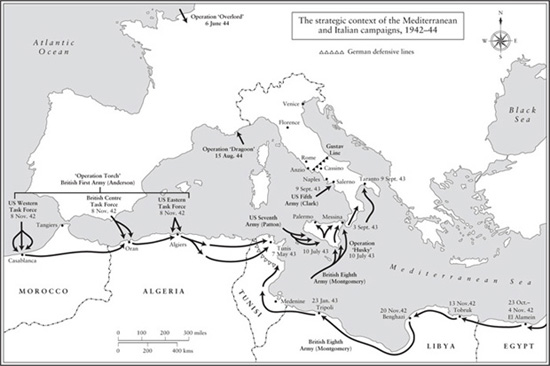
Alexanders Army Group was the fusion of the AngloUS forces that landed in Morocco and Algeria (Operation Torch) with Montgomerys Eighth Army advancing from El Alamein. While the invasion of Sicily (Husky) was a natural progression after the Allied conquest of Tunisia, future options were less clear, for Churchill and Roosevelt anticipated a simultaneous assault on France in 1944 from both the north (Overlord) and south (Dragoon). While Dragoon slipped by two months, all its resources came from the Italian theatre. The map also illustrates why Rommels proposals to defend Italy from the north attracted Hitler initially. From there, he could counter any threatened invasions of southern France or the Balkans.
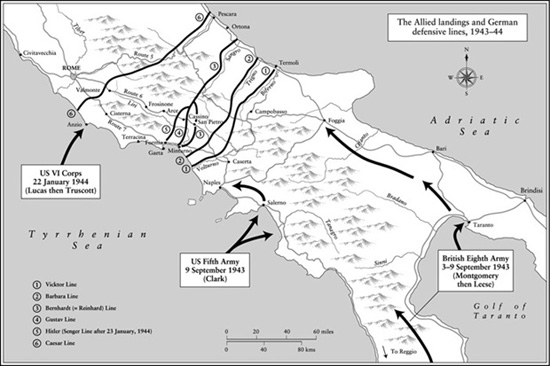
After the unexpected German success in holding Mark Clarks Fifth Army at Salerno for ten days, Hitler opted for Kesselrings plans of a southerly defence, rather than Rommels based in the north. The result was various linear positions, strung across the waist of Italy, incorporating rivers and mountains wherever possible. The Victor and Barbara lines bought time whilst the most deadly, the Bernhardt, was constructed in depth by military engineers. The Bernhardt was at its strongest in the west, where a fall-back or switch position, the Gustav, was constructed around the natural bastion of Monte Cassino.
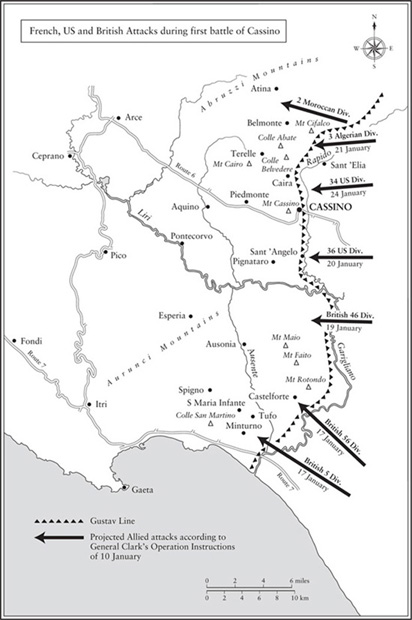
The first battle of Cassino saw a series of Allied attacks between Cassino and the coast, which were sequential, and timed to coincide with the Anzio landings. After the war the local German corps commander, General Senger, criticised this approach, as he was able to switch his reserves to meet each assault. He argued that had the Allied thrusts been simultaneous, they would have broken through. Of the attacks, the French in the north showed most promise, but was halted through lack of reinforcements. Senger, though, was most worried by the British moves in the south, which he felt would have broken through had they been properly resourced.
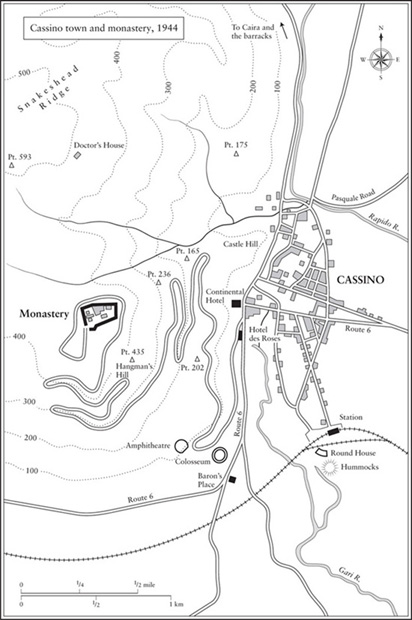
The second and third battles of Cassino were focussed on the town and monastery and overseen by Lieutenant General Sir Bernard Freyberg. For reasons of geography, attacks on the monastery were only possible from the north-west (Snakeshead Ridge) or up the sheer eastern face, leaping up the hairpin bends. The main German centres of resistance were the Continental Hotel, Hotel des Roses, Barons Palace and Station area, all extremely well-built of local stone.
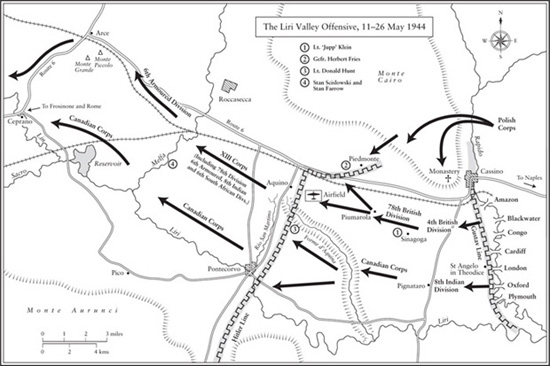
Lieutenant General Sir Oliver Leese, commanding Eighth Army, oversaw the attack and pursuit up the Liri valley. Leese had huge resources available to him comprising three corps (British XIII Corps, the Canadians and Poles), but made the mistake of cramming six Allied divisions into the valley (rarely more than five miles wide) in the final stages, slowing down the advance, rather than increasing it. This may have influenced Clark to strike for Rome, against Alexanders orders.
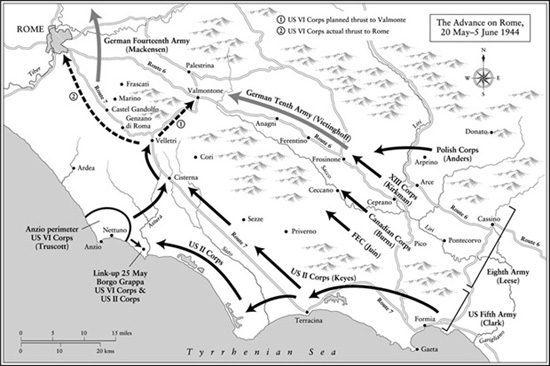
Operation Diadem, devised by Alexanders talented chief of staff, John Harding, involved both the penetration of the Gustav and Hitler Lines and a breakout from Anzio. It is notable here that each corps in the fourth battle was attacking what had been a divisional objective in the first battle. The broad idea was for Truscotts Anzio force to prevent the escape of Vietinghoffs Tenth Army, but Mark Clarks switch of emphasis towards Rome allowed the Germans to escape. However, the Germans proved very disciplined in their withdrawal and there is no guarantee that Truscotts VI Corps (who suffered heavy losses at Cisterna) would have been able to stop them at Valmonte.
, out in Italy,
Always on the vino, always on the spree.
Eighth Army skivers and their tanks,
We go to war in ties like swanks.
For were the D-Day Dodgers, in sunny Italy.
We landed at Salerno, a holiday with pay.
Jerry brought his bands out to cheer us on our way,
Showed us the sights and gave us tea,
We all sang songs, the beer was free.
For were the D-Day Dodgers, the lads that D-Day dodged.
Palermo and Cassino were taken in our stride,
We did not go to fight there, we just went for the ride.
Anzio and Sangro are just names,
We only went to look for dames,
For were the D-Day Dodgers, in sunny Italy.
On our way to Florence, we had a lovely time,
We drove a bus from Rimini, right through the Gothic Line,
Then to Bologna we did go,
And went bathing in the River Po,
For were the D-Day Dodgers, the lads that D-Day dodged.
We hear the boys in France are going home on leave,
After six months service such a shame theyre not relieved.
Font size:
Interval:
Bookmark:
Similar books «Monte Cassino: Ten Armies in Hell»
Look at similar books to Monte Cassino: Ten Armies in Hell. We have selected literature similar in name and meaning in the hope of providing readers with more options to find new, interesting, not yet read works.
Discussion, reviews of the book Monte Cassino: Ten Armies in Hell and just readers' own opinions. Leave your comments, write what you think about the work, its meaning or the main characters. Specify what exactly you liked and what you didn't like, and why you think so.

